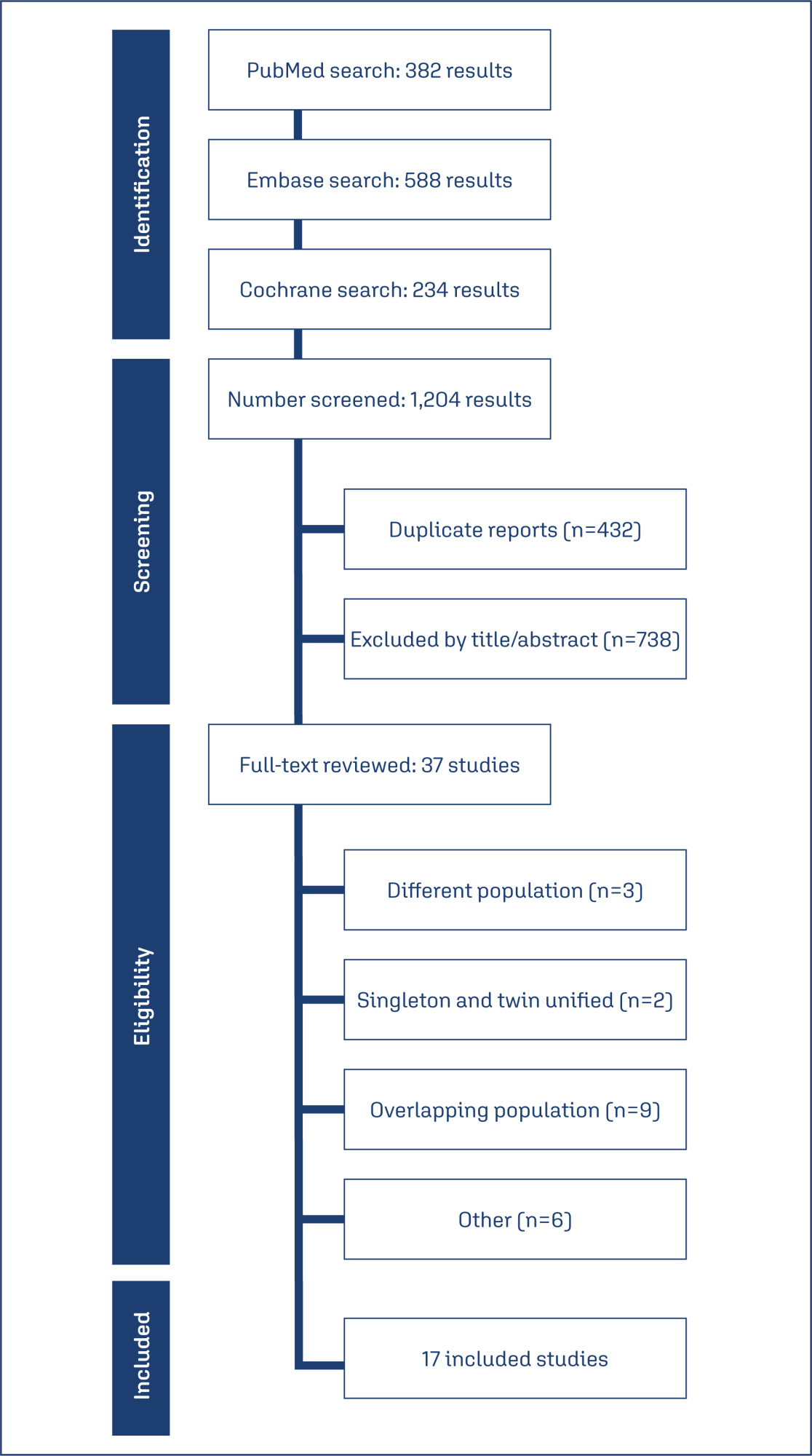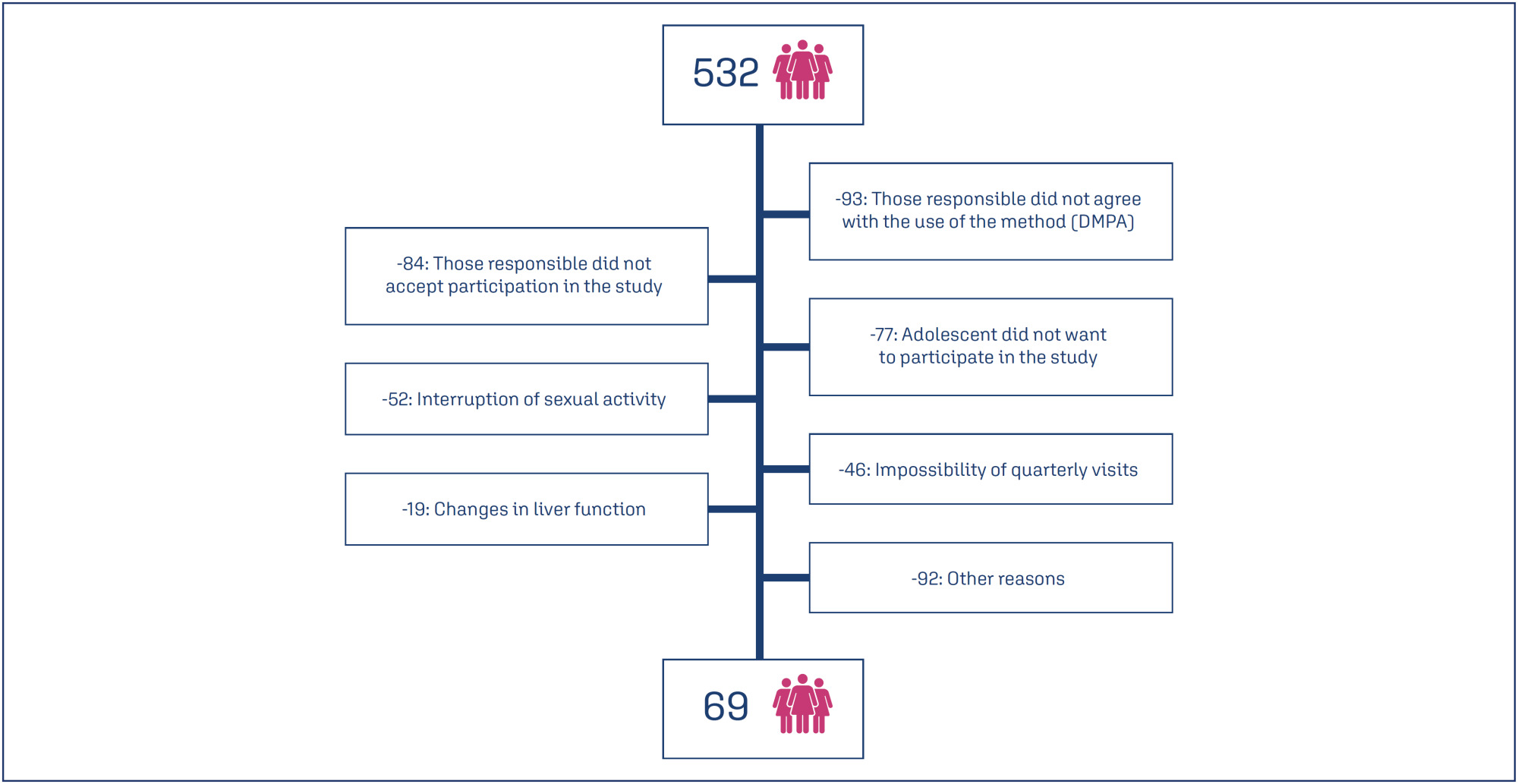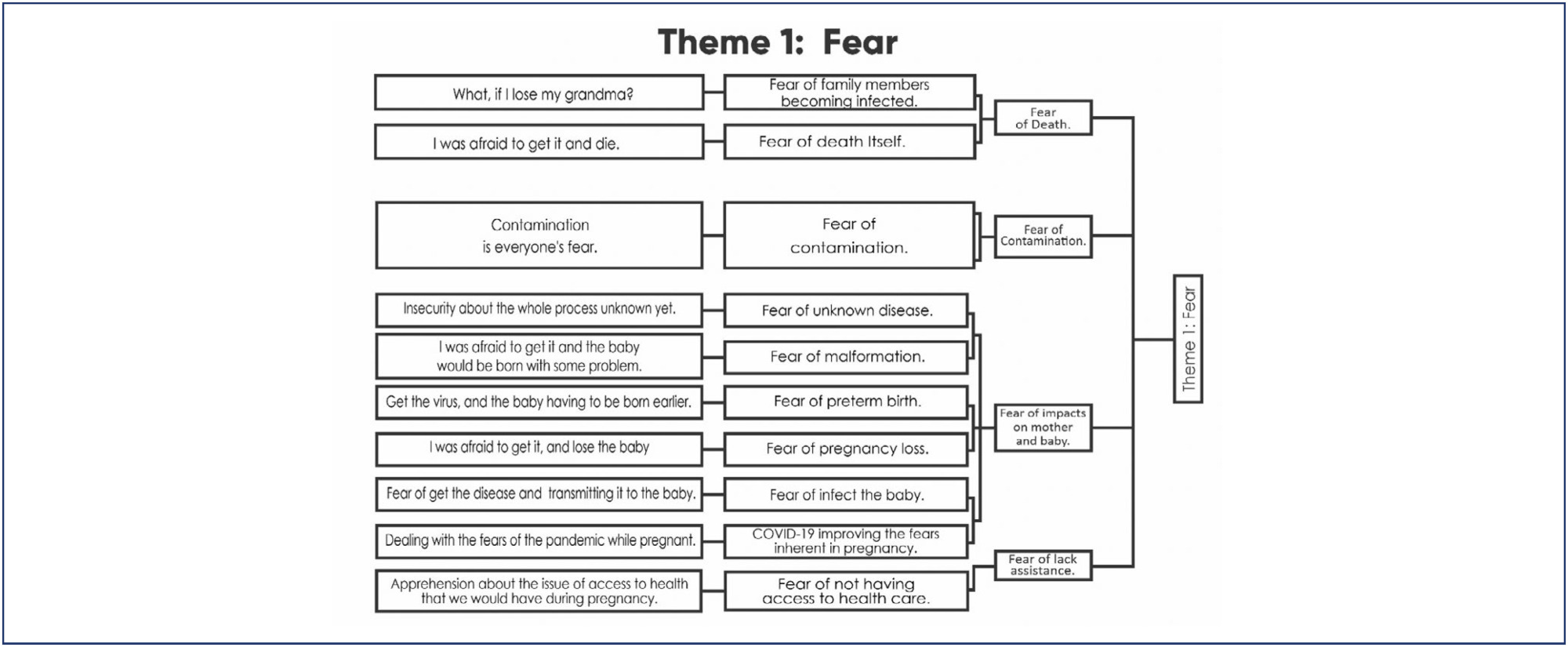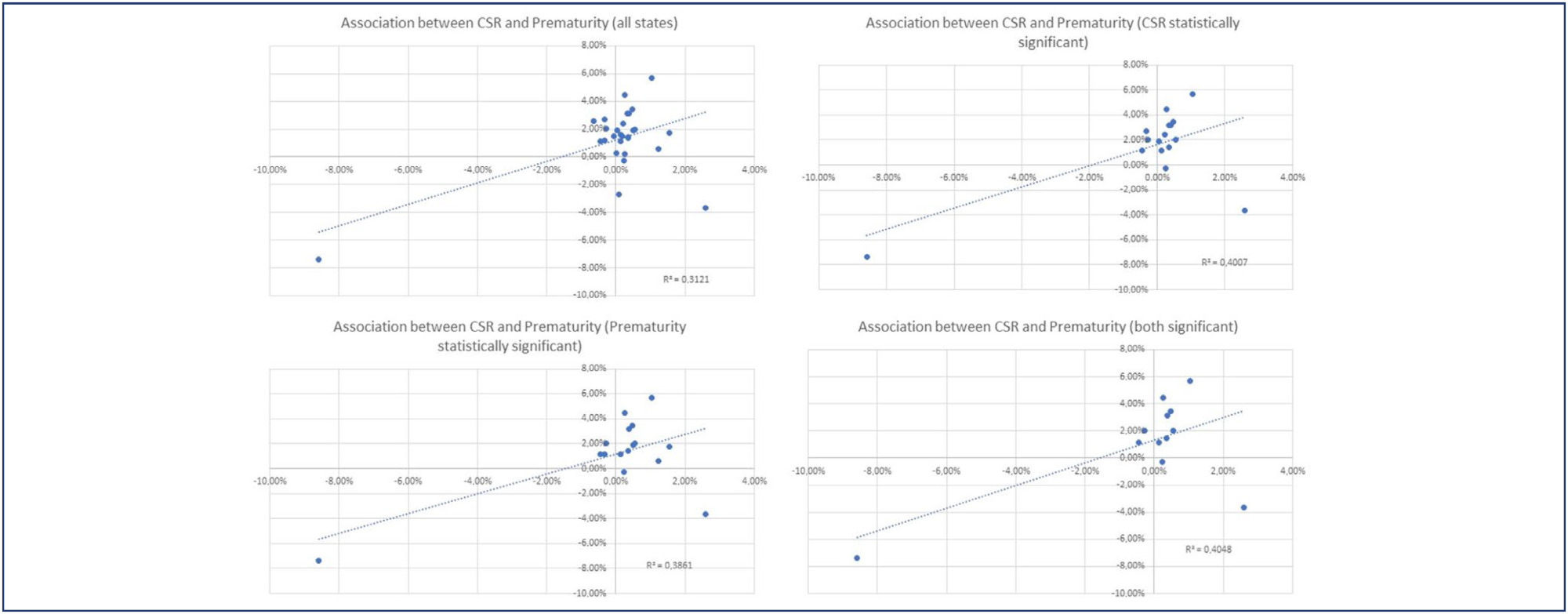-
Artigo Original30/04/2025
Depression, anxiety, sexual function and quality of life in women with hyperprolactinemia
Revista Brasileira de Ginecologia e Obstetrícia. 2025;47:e-rbgo7
Resumo
Artigo OriginalDepression, anxiety, sexual function and quality of life in women with hyperprolactinemia
Revista Brasileira de Ginecologia e Obstetrícia. 2025;47:e-rbgo7
Visualizações144Abstract
Objective:
To evaluate anxiety, depression, sexual function and quality of life in women with hyperprolactinemia.
Methods:
Cross-sectional study with 80 women divided into two groups: 30 women with hyperprolactinemia (Study Group) followed and treated at the endocrine gynecology outpatient clinic and 50 women without hyperprolactinemia, with regular menstrual cycles (Control Group) followed at the family planning outpatient clinic of the State University of Campinas from June 2021 to October 2022. Sociodemographic characteristics, quality of life (SF-36 Questionnaire), sexual function (Female Sexual Function Index Questionnaire), depression (Beck Depression Inventory) and anxiety (Beck Anxiety Scale) were evaluated in both groups. Categorical variables were described as absolute frequency and percentage; numerical variables as mean and standard deviation. Comparison of numerical variables between two groups was performed by Mann-Whitney test, while categorical were compared by Chi-Square or Fisher’s exact tests.
Results:
The mean age of women with hyperprolactinemia was 39.6±8.1 years and the Control Group was 31.2±9.5 years (p<0.001). There was no difference in anxiety scores (p=0.66), depression (p=0.08) and general sexual function (p=0.08) in both groups. However, women with hyperprolactinemia had lower scores in the domains of pain and arousal and worse functional capacity than Control Group (p<0.05).
Conclusion:
Women with hyperprolactinemia under treatment do not show any impairment in their anxiety, depression and sexual function when compared to women without hyperprolactinemia. However, analysis of quality of life showed that women with hyperprolactinemia have poor functional capacity.
Palavras-chave: AnxietyDepressionHyperpituitarismHyperprolactinemiaQuality of lifesexual functionsurveys and questionnairesVer mais -
FEBRASGO POSITION STATEMENT28/03/2025
Follow-up of women after gynecological cancer treatment
Revista Brasileira de Ginecologia e Obstetrícia. 2025;47:e-FPS3
Resumo
FEBRASGO POSITION STATEMENTFollow-up of women after gynecological cancer treatment
Revista Brasileira de Ginecologia e Obstetrícia. 2025;47:e-FPS3
Visualizações243Ver maisKey points
•The population of female cancer survivors has increased over the last few years, highlighting the importance of appropriate follow-up of these patients.
•The main objective of long-term follow-up for patients treated for cancer is the early detection of recurrences, whether local, lymph node or distant metastases.
•Symptom assessment and physical examination play an important role in the follow-up of patients treated for gynecological neoplasms.
•The use of laboratory or imaging tests to detect recurrence in asymptomatic patients should be based on evidence that it improves survival or provides less morbid treatments, also considering cost and availability.
-
Carta ao Editor18/03/2025
Comment on: Access and adequacy of antenatal care in during two phases of the COVID-19 pandemic
Revista Brasileira de Ginecologia e Obstetrícia. 2025;47:e-rbgo12
Resumo
Carta ao EditorComment on: Access and adequacy of antenatal care in during two phases of the COVID-19 pandemic
Revista Brasileira de Ginecologia e Obstetrícia. 2025;47:e-rbgo12
Visualizações209The publication on “Access and adequacy of antenatal care in a city in Brazil during two phases of the COVID-19 pandemic.”() Is an interesting issue. This study investigated antenatal care consumption and appropriateness among postpartum caregivers at Florianópolis Hospital from 2020 to 2022, with an emphasis on socio-demographic characteristics and antenatal care. Although this study […]Ver mais -
Carta ao Editor18/03/2025
Use of calcium during pregnancy: far beyond pre-eclampsia
Revista Brasileira de Ginecologia e Obstetrícia. 2025;47:e-rbgo11
Resumo
Carta ao EditorUse of calcium during pregnancy: far beyond pre-eclampsia
Revista Brasileira de Ginecologia e Obstetrícia. 2025;47:e-rbgo11
Visualizações253Dear Editor,We read with interest the Editorial of the Revista Brasileira de Ginecologia e Obstetrícia (RBGO) in which Braga et al. present the initiative of the state of Rio de Janeiro (Brazil) for prediction and secondary prevention of pre-eclampsia.() The authors highlight universal calcium supplementation during pregnancy as a significant innovation, implemented for the first […]Ver mais -
Artigo de Revisão18/03/2025
Short cervix and use of cervical pessary for preventing preterm birth in singleton and twin pregnancies: a systematic review and meta-analysis
Revista Brasileira de Ginecologia e Obstetrícia. 2025;47:e-rbgo10
Resumo
Artigo de RevisãoShort cervix and use of cervical pessary for preventing preterm birth in singleton and twin pregnancies: a systematic review and meta-analysis
Revista Brasileira de Ginecologia e Obstetrícia. 2025;47:e-rbgo10
Visualizações229Ver maisAbstract
Objective:
Preterm birth remains a significant contributor to neonatal morbidity and mortality. The use of cervical pessaries as an intervention for preventing preterm delivery in women with a short cervix has been a subject of interest. We evaluated the effectiveness of cervical pessary compared to standard care in preventing preterm delivery in women with a short cervix.
Data source:
Databases were systematically searched in PubMed, Cochrane, and Embase databases in December 2023.
Study selection:
Randomized clinical trials with the outcomes of interest were included.
Data collect:
We computed risk ratios for binary endpoints, with 95% confidence intervals. Heterogeneity was assessed using I2 statistics. Data were analyzed using R software (version 4.3.0). The primary outcomes of interest were preterm delivery before 37 weeks, and preterm delivery before 34 weeks.
Data synthesis:
Seventeen studies with 5,704 patients were included. The use of cervical pessary was associated with a decreased risk of preterm delivery before 37 (RR 0.88; 95% CI 0.81-0.96) and 34 weeks (RR 0.79; 95% CI 0.63-0.99) of gestation in twin pregnancies as compared to standard care without progesterone. There were no significant differences in preterm delivery in singleton pregnancy, neonatal outcomes, preterm premature rupture of the membranes or chorioamnionitis.
Conclusion:
The use of cervical pessary was associated with a significant reduction in preterm delivery at 34 and 37 weeks of gestation in twin pregnancies among patients with a short cervix compared to no treatment. No significant difference was found in singleton pregnancies or maternal outcomes.

-
Comunicação Breve18/03/2025
Contraception in adolescents with mental disorders: adherence and satisfaction in the use of depot medroxyprogesterone acetate
Revista Brasileira de Ginecologia e Obstetrícia. 2025;47:e-rbgo9
Resumo
Comunicação BreveContraception in adolescents with mental disorders: adherence and satisfaction in the use of depot medroxyprogesterone acetate
Revista Brasileira de Ginecologia e Obstetrícia. 2025;47:e-rbgo9
Visualizações237Abstract
Objective:
To evaluate the continuation rate, satisfaction, and reasons for discontinuation of depot medroxyprogesterone acetate (DMPA) in adolescents treated in a mental health service.
Methods:
Prospective cohort study conducted in a reference unit for the care of adolescents with mental disorders (MDs) and intellectual disabilities (IDs). All patients received a gynecological consultation and an educational group on contraceptive methods. Sociodemographic data on age, education and gynecological data (menarche, coitarche, regularity of menstrual cycles and presence of symptoms) were collected. Follow-up was quarterly for 12 months, during which symptoms, desire to continue, and satisfaction with the use of the quarterly injectable were assessed.
Results:
Eight hundred and sixty-two sexually active adolescents were supported, 532 adolescents chose to use the quarterly injectable, and 69 of these agreed to participate in the study. The mean age of users was 15.5 years (SD=0.91). After 12 months of follow-up, 34 (49.3%) of the 69 adolescents continued to use the method and 36 (52.3%) were satisfied. Among the 33 (47.8%) who discontinued use, the most common reasons were irregular bleeding and weight gain.
Conclusions:
Adolescents with intellectual disabilities and/or other mental disorders showed a significant rate of continuation and satisfaction with the use of the depot medroxyprogesterone acetate at 12 months, and the most common reasons for discontinuation were irregular uterine bleeding and weight gain.
Palavras-chave: ContraceptionMedroxyprogesterone acetateMental disordersPregnancyPregnancy in adolescenceVer mais
-
Artigo Original18/03/2025
The experience of pregnancy in the COVID-19 pandemic
Revista Brasileira de Ginecologia e Obstetrícia. 2025;47:e-rbgo8
Resumo
Artigo OriginalThe experience of pregnancy in the COVID-19 pandemic
Revista Brasileira de Ginecologia e Obstetrícia. 2025;47:e-rbgo8
Visualizações293Ver maisAbstract
Objective:
To describe women’s experience of pregnancy during the COVID-19 pandemic.
Methods:
A qualitative study conducted in a private maternity hospital, from May, 2020 to November, 2021, with women aged ≥ 18 years, gestational age ≥ 36 weeks at birth and ≥ 24 hours post-partum. Data collected through semi-structured interviews, recorded, transcribed, and analyzed adopting Krippendorff’s Content Analysis as theoretical-methodological framework.
Results:
Four main themes emerged: Fear, Taking care and celebrating pregnancy: adjusting to the new reality, Harms of Isolation, and Benefits of Isolation. The fear of contamination and its impact on the health of mother and child resulted in the adoption of severe social isolation, including from those considered sources of support by the expecting mother. Overwhelmed, some of the participants reported loneliness and psychic suffering. The opportunity to focus on the pregnancy, the preparations for the arrival of the child, and the family made isolation a beneficial and positive period for other women.
Conclusion:
The experience of pregnancy in the Pandemic was an event outside of the ordinary and common. The expecting mother faced her worst fears on a daily basis and attended prenatal care, in order to ensure her child would be born healthy. The celebration of the baby’s life, amid so many deaths, had to be adjusted to the virtual environment. It was a tense, solitary, and ambiguous period, which demanded a lot from the mental health of some participants, but to others, brought advantages that would not have been possible in different times.

-
Artigo Original18/03/2025
Effect of COVID-19 on Brazilian cesarean and prematurity rates: a cross-sectional study
Revista Brasileira de Ginecologia e Obstetrícia. 2025;47:e-rbgo6
Resumo
Artigo OriginalEffect of COVID-19 on Brazilian cesarean and prematurity rates: a cross-sectional study
Revista Brasileira de Ginecologia e Obstetrícia. 2025;47:e-rbgo6
Visualizações232Abstract
Objective:
To investigate the relationship between prematurity and cesarean section rate in Brazil during the beginning of COVID-19 pandemic.
Methods:
Utilizing the Robson Classification, this study analyzed data from the Brazilian Ministry of Health’s Live Births Panel, comparing CSR) and group 10 (preterm deliveries) between 2019 (pre-pandemic) and 2021 (pandemic) in each of Brazilian states and the overall country. The prematurity and CSR were compared using prevalence ratio and confidence interval, and p-value was obtained. The variation of prematurity and CSR were compared through the coefficient of determination (R2).
Results:
A total of 5,522,910 deliveries were evaluated during the period. The CSR increased from 56.34% to 57.05% (p<0.01), and the frequency of preterm deliveries rose from 8.99% to 9.13% (p<0.01). The CSR increased in 23 States and decreased in 4 States, while the prematurity rate increased in 16 States and decreased in 10 States. A positive relationship between the increase of CSR and prematurity was observed during COVID-19, with an R2 value of 0.3121, suggesting a moderate association between these two variables.
Conclusion:
Between 2019 (pre-COVID-19 pandemic) and 2021 (the first full year of the COVID-19 pandemic), there was an increase in prematurity and CSR in Brazil. These increases were observed in most Brazilian states and may be correlated. However, it is impossible to establish a cause-effect relationship given the design of this study.
Palavras-chave: Cesarean deliveryCOVID-19Infant, newbornLive birthMaternal mortalitypandemicsPrematurityVer mais
-
Editorial17/02/2012
Aborto legal: o conhecimento dos profissionais e as implicações das políticas públicas
Revista Brasileira de Ginecologia e Obstetrícia. 2012;34(1):1-3
Resumo
EditorialAborto legal: o conhecimento dos profissionais e as implicações das políticas públicas
Revista Brasileira de Ginecologia e Obstetrícia. 2012;34(1):1-3
DOI 10.1590/S0100-72032012000100001
Visualizações60EDITORIAL Aborto legal: o conhecimento dos profissionais e as implicações das políticas públicas[…]Ver mais -
20/05/2011
Nota do editor
Revista Brasileira de Ginecologia e Obstetrícia. 2011;33(1):59-59
-
FEBRASGO POSITION STATEMENT18/10/2021
Contraceptive counseling during the pandemic: practical guidelines
Revista Brasileira de Ginecologia e Obstetrícia. 2021;43(7):579-584
Resumo
FEBRASGO POSITION STATEMENTContraceptive counseling during the pandemic: practical guidelines
Revista Brasileira de Ginecologia e Obstetrícia. 2021;43(7):579-584
-
Artigo Original20/06/2002
Carcinoma Microinvasor no Cone Pós Biópsia Dirigida Compatível com NIC 3
Revista Brasileira de Ginecologia e Obstetrícia. 2002;24(1):37-43
Resumo
Artigo OriginalCarcinoma Microinvasor no Cone Pós Biópsia Dirigida Compatível com NIC 3
Revista Brasileira de Ginecologia e Obstetrícia. 2002;24(1):37-43
DOI 10.1590/S0100-72032002000100006
Visualizações61Ver maisObjetivo: determinar os fatores associados ao achado de carcinoma microinvasor no cone de mulheres com biópsia colpodirigida prévia compatível com neoplasia intra-epitelial cervical (NIC) 3 e avaliar a proporção de margens comprometidas. Pacientes e Métodos: foram revisados os prontuários de 385 mulheres (média de idade: 39 anos) submetidas à conização a frio ou por cirurgia de alta freqüência (CAF) com alça no período de janeiro de 1993 a julho de 2000. Estes procedimentos foram indicados por biópsia compatível com NIC 3. Resultados: o diagnóstico do cone foi compatível com NIC 3 em 243 mulheres (63%) e com NIC 2 em 13 (3%). Apenas 10 apresentaram HPV/NIC 1 (3%) e oito não tinham doença residual no cone. Entretanto, 101 mulheres apresentaram carcinoma microinvasor no cone (26%) e 10 (3%) carcinoma invasor franco. A idade, o estado menstrual e o número de partos não estiveram relacionados com a gravidade da lesão no cone. Mulheres com alterações da colpocitologia oncológica sugestivas de invasão apresentaram um risco significativamente maior de apresentar carcinoma microinvasor ou invasor no histológico final (p<0,01), embora 52 das 243 mulheres com NIC 2 ou NIC 3 no cone também tivessem sugestão de invasão na colpocitologia. Entre as mulheres com NIC 2 ou 3, 44% apresentaram epitélio branco, 21% pontilhado e 17% mosaico. Esta proporção foi semelhante nas mulheres com carcinoma microinvasor ou invasor, sendo estas imagens encontradas, respectivamente, em 37%, 23% e 21%. O comprometimento das margens do cone foi significativamente maior nas mulheres submetidas a CAF (49%) do que naquelas submetidas à conização a frio (29%). Conclusão: a ausência de fatores independentes clínicos e colposcópicos que se associam com o achado de carcinomas microinvasivos em mulheres submetidas à conização por biópsia compatível com NIC 3 justifica a excisão cônica da junção escamo-colunar nas lesões cervicais de alto grau.
-
Editorial07/02/2006
The obstetrician ethical responsibility in the diagnosis and treatment of gestational diabetes mellitus (GDM)
Revista Brasileira de Ginecologia e Obstetrícia. 2006;28(10):571-574
Resumo
EditorialThe obstetrician ethical responsibility in the diagnosis and treatment of gestational diabetes mellitus (GDM)
Revista Brasileira de Ginecologia e Obstetrícia. 2006;28(10):571-574
-
Resumo De Tese01/11/2007
Estudo analítico dos pólipos endometriais: a importância da polipectomia
Revista Brasileira de Ginecologia e Obstetrícia. 2007;29(8):436-436
Resumo
Resumo De TeseEstudo analítico dos pólipos endometriais: a importância da polipectomia
Revista Brasileira de Ginecologia e Obstetrícia. 2007;29(8):436-436
DOI 10.1590/S0100-72032007000800011
Visualizações41RESUMO DE TESE Estudo analítico dos pólipos endometriais: a importância da polipectomia […]Ver mais -
Editorial02/05/2007
Ensino da cirurgia ginecológica nos programas de residência médica do Brasil
Revista Brasileira de Ginecologia e Obstetrícia. 2007;29(2):61-66
Resumo
EditorialEnsino da cirurgia ginecológica nos programas de residência médica do Brasil
Revista Brasileira de Ginecologia e Obstetrícia. 2007;29(2):61-66
DOI 10.1590/S0100-72032007000200001
Visualizações44EDITORIAL Ensino da cirurgia ginecológica nos programas de residência médica do Brasil[…]Ver mais -
Artigo Original22/04/2009
Causas do retardo na confirmação diagnóstica de lesões mamárias em mulheres atendidas em um centro de referência do Sistema Único de Saúde no Rio de Janeiro
Revista Brasileira de Ginecologia e Obstetrícia. 2009;31(2):75-81
Resumo
Artigo OriginalCausas do retardo na confirmação diagnóstica de lesões mamárias em mulheres atendidas em um centro de referência do Sistema Único de Saúde no Rio de Janeiro
Revista Brasileira de Ginecologia e Obstetrícia. 2009;31(2):75-81
DOI 10.1590/S0100-72032009000200005
Visualizações55OBJETIVO: avaliar os fatores que levam ao retardo na confirmação diagnóstica de lesões mamárias suspeitas de câncer. MÉTODOS: foi realizado um estudo observacional de corte transversal. Foram incluídas 104 mulheres que procuraram um hospital de câncer, com diagnóstico ou suspeita de câncer de mama. Foi aplicado um questionário semiestruturado com perguntas referentes às características demográficas, clínicas e de utilização de serviços. As variáveis foram comparadas pelos testes t de Student, Mann-Whitney, χ2 de Pearson ou exato de Fisher, conforme a indicação. A fim de identificar as variáveis associadas ao retardo na confirmação diagnóstica do câncer de mama, foram calculadas as Odds Ratio (OR) com intervalo com 95% de confiança (IC95%) e um modelo de regressão logística foi elaborado. RESULTADOS: a média de idade foi de 54 anos (±12,6), predominando mulheres brancas (48,1%), casadas (63,5%), residentes no Município do Rio de Janeiro (57,7%) e com baixo grau de escolaridade (60,6%). O tempo mediano entre o primeiro sinal ou sintoma da doença e a primeira consulta foi de um mês, e desta última até a confirmação diagnóstica de 6,5 meses. Em 51% das mulheres o diagnóstico foi tardio (estádios II a IV). Presença de sintomas, longo intervalo de tempo entre o início dos sintomas e a primeira avaliação e entre o início dos sintomas e a confirmação diagnóstica, mostraram-se fatores significantes (p<0,05) para o retardo na obtenção do diagnóstico de lesões suspeitas. CONCLUSÕES: os resultados deste estudo sugerem que os esforços devem ser concentrados na redução dos tempos necessários para agendar a consulta médica e para o esclarecimento do diagnóstico de lesões suspeitas, bem como na educação dos médicos e das mulheres sobre a importância dos sintomas mamários e o valor da avaliação, diagnóstico e tratamento precoce.
Palavras-chave: Educação em saúdeFatores de riscoNeoplasias da mamaPromoção da saúdeSistema Único de SaúdeVer mais
Busca
Pesquisar em:
Nuvem de Tags
Gravidez (167)Fatores de risco (89)Menopausa (79)Pré-eclâmpsia (66)Endometriose (65)Mama (59)Infertilidade (58)Obesidade (57)Complicações na gravidez (56)Diagnóstico pré-natal (54)Gestação (54)Qualidade de vida (53)Saúde da mulher (51)Cesárea (50)Complicações da gravidez (50)Neoplasias da mama (49)Fertilização in vitro (48)Cuidado pré-natal (47)Mortalidade materna (43)Ultra-sonografia (43)


